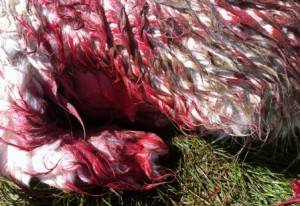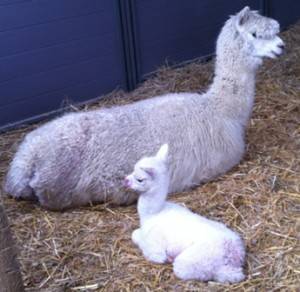Breech birth in Alpaca – warning do not read if you are squeamish or sensitive
I managed to put together some photographs of the breach birth of exactly one week ago today. Into the pouring rain she started in labour at the same time as another female. A seasoned girl with several cria behind her and no complications previously. WARNING I have deliberately set this out in order (obviously I was attending to the Alpaca so not in actual order) to go below – so if you are squeamish do not read this at all or skip to the end please.
controversially, perhaps I should not put this on a blog and continue to let everyone think that farming Alpaca is just petting furry creatures with big eyes but farming is not like that. it is a 24/7 round the clock role 365 days a year and “with live stock, there is always dead stock”. Hopefully this will give a better insight into the actual care needed for Alpaca and other livestock farming. Always expect the unexpected and you will do fine.
The female started in labour lying sideways as in previous births. Another Alpaca started in labour at pretty much the same time and also the heavens opened so I knew it was going to be busy.
The female took herself off to be alone and that was when the first warning bells went off in in my head – this was a female who liked to birth “amongst friends”. Ironically I took a phone call from my Vet at precisely that time to give me some results over the phone (all normal) and I said to her then “are you on call later as I am thinking I might have a breech starting”… I spoke to her today and she said “you were right then”
Alpaca always take different times for the first stage of labour so you cannot say “it is xx hours” not ever – they are all individual. I had noted she had started in her first signs of labour properly around the 2 hour mark from onset but I was with the pair the whole time (the other mother gave birth naturally to a stunning boy which we will talk about another day) and they were very different females.
I gave her a little longer but she started kicking her legs at the back and wanting to get wet. neither were unusual for this female but I was not happy and my years of living with my previous Vet partner had always taught me to “investigate first not last” if in doubt.
So with my son holding her head, I gently with lube (right of photo) investigated her internally and sure enough found that I was feeling a bottom not a nose and feet as I should have been. At this point I must say that Alpaca uterine walls are far more delicate than those of horses/cattle/sheep and I have large hands. I knew that I could not help her and called my vet immediately who arrived some 30 minutes later.
At this point, she had been rolling in agony now and time was running out for both her and the cria. PLEASE do not scroll down if squeamish.
There can be no sedation for the Alpaca at this point and one has to be aware that the cria has to be pushed back inside the Alpaca in order to be able to try to turn the cria. This causes the legs to rupture the uterine walls and blood literally pours out with every attempt. No vet can keep their arms in continually and there is not much space in there.
once the placenta has been ruptured, the cria has little chance of survival and the mother also has high risk of dying from shock or infection.
The Alpaca seemed to understand we were trying to help but it seemed we would be unable to remove the cria at all at one point and we were discussing euthanasing the female. if you cannot get the cria out (dead or alive) the mother would die.
We had already varied the methods of restraining the female and all three of us gave it one last attempt which was rewarded with the cria being pulled out by its hind legs. please note that assisting all the time, obviously these shots are only taken intermittently in “breathing space” and are for the benefit of “wannabee alpaca owners” to see it is not just plain sailing!
At first it seemed the cria was dead as it was so “blue” around the gills but after towelling to stimulate and draining fluid off the lungs, it was clearly alive and needed time and its mother – who also needed incentive not to give up. no romancing here, its a fact – they needed each other.
You have to appreciate the time that passed while all of this was going on and an eternity before the mother even raised her head. the cria was kept warm and at this point we could only hope. meantime practical issues would kick in – we were at the end of a long field with night setting in, two alpaca covered in blood both cold and wet which would bring its own issues.
The cria was coated and as little interference as possible given whilst the mother tried to raise herself off the ground and give it the support it needed. Bonding needed to happen and once pain relief and antibiotics had been administered, the vet departed and I was left with the essential needs of these two; along with the rest of the herd.
but they were alive and the next 24 – 48 hours would tell.
Eventually the mother raised herself from the ground in a colossal effort and the cria and her bonded naturally, if in a bit of a macabre state.
I cannot tell you how long it took before we were able to get the mother and cria into the barns, one step at a time with ten minute rests in between but eventually it was done and at this point I can advise the cria was premature of only 10 months and two weeks gestation. Hence its legs simply could not hold it and essential colostrums were getting crucial so were given by bottle.
As night continued, we held the cria on several occasions to encourage it to suckle from its mother and she certainly had the will to survive. Then the slight matter of cleaning them without getting them cold.
or upsetting the newly bonded pair. The cria was blow dried to warm it and dry the coat which otherwise would have dried naturally by this point.
I do not need to tell you that it was a very long 48 hours before we sensed the pair would make it – and it is still early days – and the legs of the cria are strengthening daily. She drinks from her mother and with her mum having a radical hair cut to remove all staining we are on constant alert still for infection and fly strike amongst other things.
The cria has the advantage of the only mother with a fleece at the moment as shearing took place on the Sunday after the breach on the Friday – no way could the mother be shorn – so the heat at the moment is taking its toll but our shearers will come out as soon as we feel she is able to be shorn. fingers crossed still but I end this blog with a “happier” pair photo!















